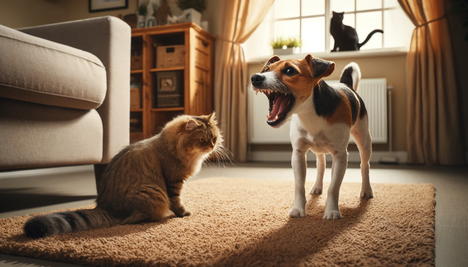Attribute "Not cat-friendly"

"Not cat friendly": what it really means for a dog breed
You've probably heard the saying "like cats and dogs", which is often used to describe enemies. But what does it really mean when a dog breed is described as "not cat friendly"? Does it mean that the dog hates cats? Or maybe that it wants to chase them? In this article, we'll explain exactly what this trait means, why it occurs in some dogs and how you can deal with it as a dog owner.
What does 'not cat friendly' mean?
When a dog breed is labeled as "not cat friendly", it usually means that these dogs tend to have difficulty living peacefully with cats. This can be for a variety of reasons, such as hunting instinct, territorial behavior or poor socialization experiences with cats. Here are some of the most common reasons:
1. strong hunting instinct
Many dog breeds were originally bred to hunt or herd. These dogs often have a strong hunting instinct. A running cat can look like prey to them, which triggers the hunting instinct. Breeds such as the Jack Russell Terrier or the Siberian Husky are known for this.
2. territoriality
Dogs are territorial by nature. Some breeds tend to be particularly defensive of their home and family. A cat in the same household could be seen as an intruder, leading to conflict. Protective instincts are strong in breeds such as the Rottweiler or the German Shepherd.
3. lack of socialization
Another important factor is socialization. If a dog has never learned how to behave towards cats, this can lead to misunderstandings and aggression. Dogs that have not had positive experiences with cats in their puppyhood may have problems getting used to them.
Why do some dog breeds have this trait?
The answer often lies in the breeds' history and original tasks. Here are some examples:
1. hunting dogs
Breeds such as the Beagle or the Weimaraner were bred to hunt and catch small animals. Their natural instinct is to chase anything that moves quickly, including cats.
2. working dogs
Working dogs such as the Border Collie or Australian Cattle Dog were bred to herd flocks. Their herding instinct can lead them to chase cats or try to "herd" them, which of course does not go down well with cats.
3. guard dogs
Breeds such as the Doberman or Bullmastiff were bred as guard dogs. Their protective instinct can lead them to see a cat as a threat and react accordingly.
How can you deal with this?
If you have a dog that is not cat-friendly, there are still ways to make a harmonious coexistence possible:
1. slow introduction
Introduce your dog and cat to each other slowly and in controlled situations. Use a lead and separate them with a baby gate or door if necessary.
2. positive reinforcement
Reward your dog for calm and peaceful behavior around the cat. Positive reinforcement can work wonders and help your dog understand that good behavior towards the cat is rewarded.
3. create separate areas
Make sure that both the dog and the cat have their own retreats where they can feel safe. This allows both animals to reduce stress and relax.
4. seek professional help
If the situation is particularly difficult, do not hesitate to consult a professional dog trainer or behavior consultant. These experts can create individual training plans and help you improve your dog's behavior.
Labeling a dog breed as "not cat friendly" does not mean that it is impossible for dogs and cats to live together peacefully. With patience, training and the right approach, many dogs can learn to accept cats and live in a harmonious household. If you understand the background and take appropriate measures, nothing stands in the way of dogs and cats living together peacefully!



